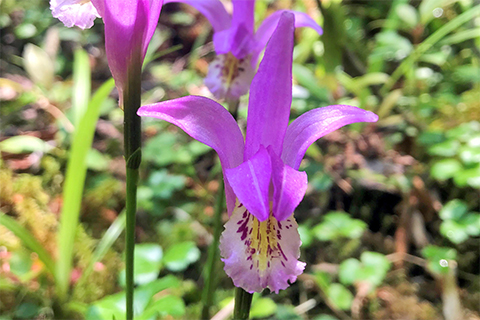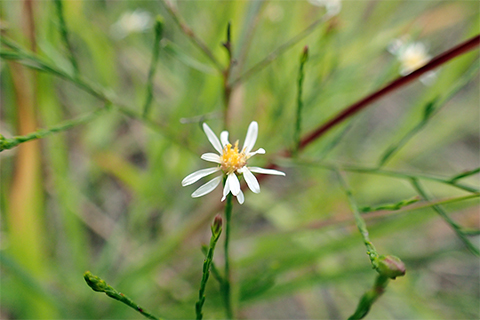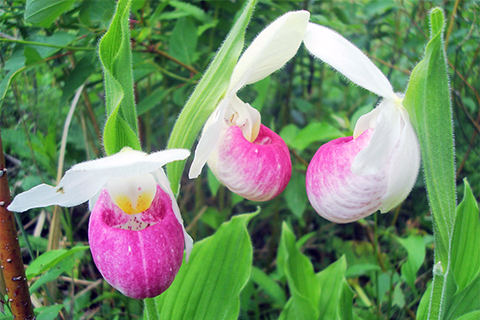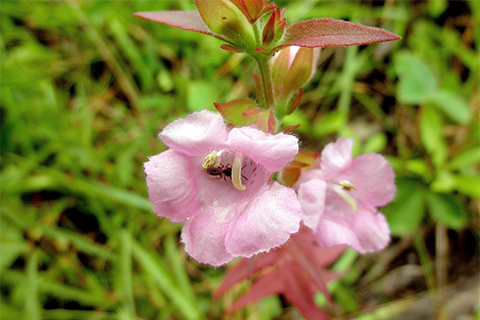When you hear “endangered species,” what comes to mind? Siberian tigers in China or black rhinos in southern Africa might ring a bell.
The words “endangered species” may bring to mind exotic species in far-away places, but endangered species are closer to home than you might think.
Responsibilities for Pennsylvania’s Wild Resources

Dragon’s mouth orchid -- PA endangered
The Pennsylvania Game Commission lists birds and mammals as endangered or threatened.
The Pennsylvania Fish and Boat Commission is responsible for listing fish, reptiles, amphibians, and aquatic invertebrates like mussels.
DCNR is responsible for classifying plants.
The Wild Resource Conservation Program is an important source of funding for endangered flora and fauna in Pennsylvania; in fact, it is the only source of funding for plant conservation!
Why Are Plants Important to Biodiversity?
Plants play a major role in every ecosystem on the planet. They create the oxygen we breathe and are the first link in the food chain.
They convert energy from the sun into useable forms. In fact, plants are so important that a special law, the Wild Resource Conservation Act, established a procedure for protection of wild flora in Pennsylvania.
DCNR has jurisdiction for native wild plants in Pennsylvania, which includes:
- Investigating plant populations
- Classifying them
- Providing for their conservation
DCNR manages the Wild Resources Conservation Program, created in 1982, to aid in the conservation of the commonwealth’s flora and non-game fauna. The program identifies research and conservation needs.
The program also provides grants to researchers, conservationists, and educators to help understand the issues facing plants and animals in Pennsylvania.
How Plants Become Listed

Serpentine aster -- PA threatened, Jason Ryndock, Pennsylvania Natural Heritage Program
Plants can become endangered because of changes in habitat, such as too much shade from nearby trees, harvesting from the wild, or by loss of habitat from development.
The Wild Resources Conservation Program helps people better understand the problems plants are facing by conducting studies on plants in the wild, in herbaria (libraries of pressed plant specimens) and even genetic studies.
Researchers write reports and submit them to DCNR. These reports help DCNR decide which species need to be listed as endangered or threatened, and what type of actions are needed to maintain their critical habitat.
Pennsylvania has about 2,000 native plants, as well as hundreds of mosses, liverworts, and lichens.
Of these native plants, 582 are classified by DCNR, with 349 considered rare, threatened, or endangered in Pennsylvania.
DCNR’s Work to Protect Wild Plants

Showy lady's slipper -- PA threatened/proposed endangered, Chris Tracey, Pennsylvania Natural Heritage Program
DCNR manages 2.2 million acres of state forest land and about 300,000 acres of state park lands for the conservation of native wild plants for the benefit of all Pennsylvanians.
On DCNR lands and other lands across the commonwealth, the department is committed to conserving native plant species by:
- Classifying plants as rare, threatened, or endangered and conserving them
- Promoting the use of native plantings in landscaping and revegetation efforts to maintain protection of the commonwealth’s native wild plants
- Managing and enhancing communities of native plants, and the habitats that they provide
- Addressing invasive plant species and educating about how to combat them
Pennsylvania Wild Plant Sanctuaries

Eared false foxglove -- PA endangered, Pennsylvania Natural Heritage Program
The department also can set up Wild Plant Sanctuaries to create a voluntary statewide network of habitat managed specifically to conserve rare native plants.
Public Wild Plant Sanctuaries are found on DCNR land and receive special management.
By designating these sites, DCNR ensures that future activities, such as recreation or timbering, will protect critical biodiversity areas while enhancing and sustaining habitat.
Wild Plant Sanctuaries can also be designated on private land. DCNR recognizes landowners for conserving rare native plants and ecological communities through designation.
How to Help Conserve Wild Plants
- Don’t harvest wild plants -- let them where they are!
- Don’t drain! Some of the most precious habitats are wetlands with unique plants and animals.
- Conserve habitat. Protecting habitat saves entire communities of animals and plants.
- Plant native plants, which are key to maintaining our natural ecosystems.
- Don’t plant invasive plants, which can wreak havoc on native ecosystems and endangered plants and animals.
- Minimize use of herbicides and pesticides, which are hazardous pollutants that affect wildlife at many levels.
- If you are a landowner, consider if your property is eligible to apply to be a Wild Plant Sanctuary (PDF).
- Visit botanical gardens, arboreta, wildlife refuges, and other locations to learn about endangered plants.